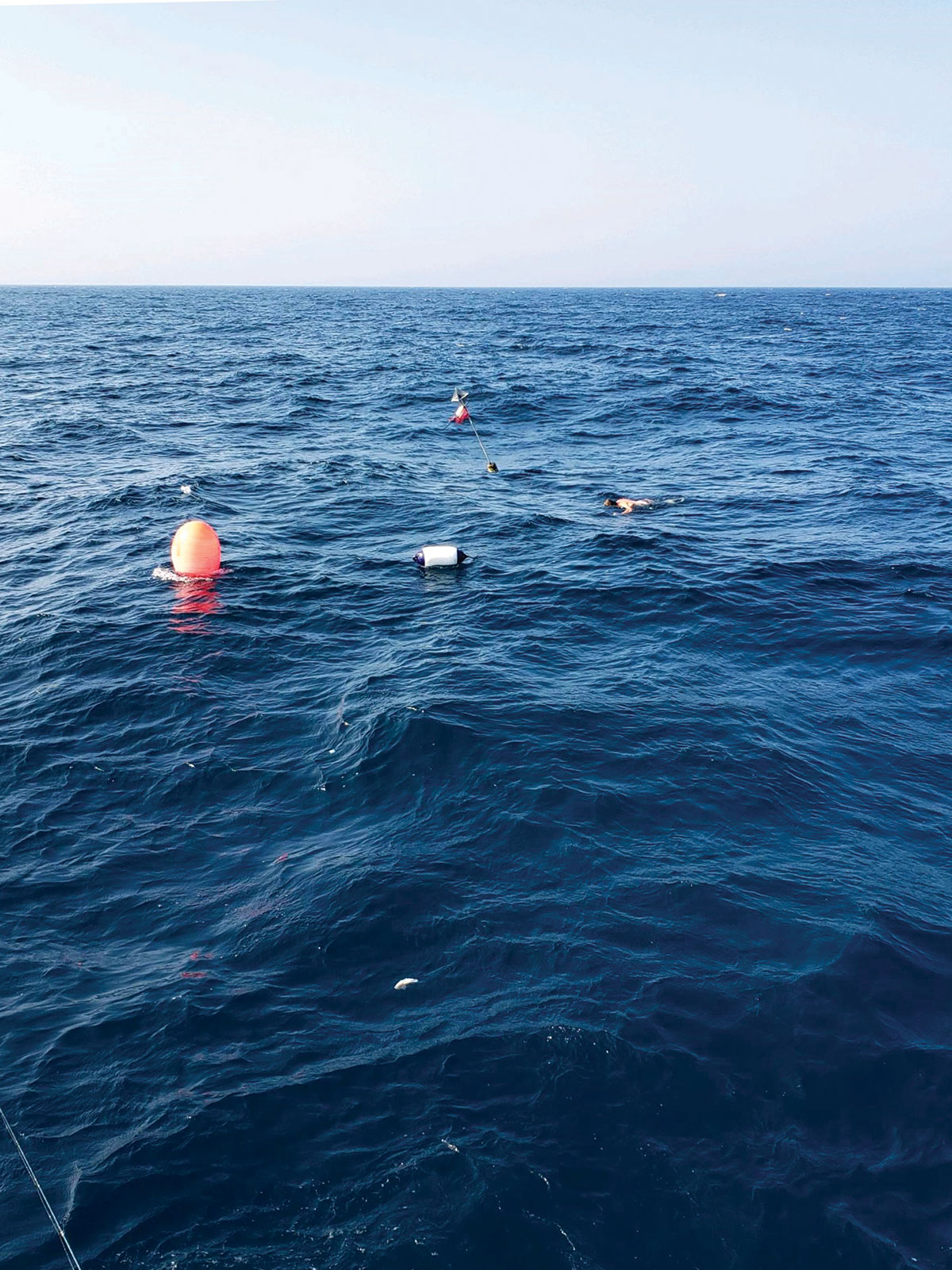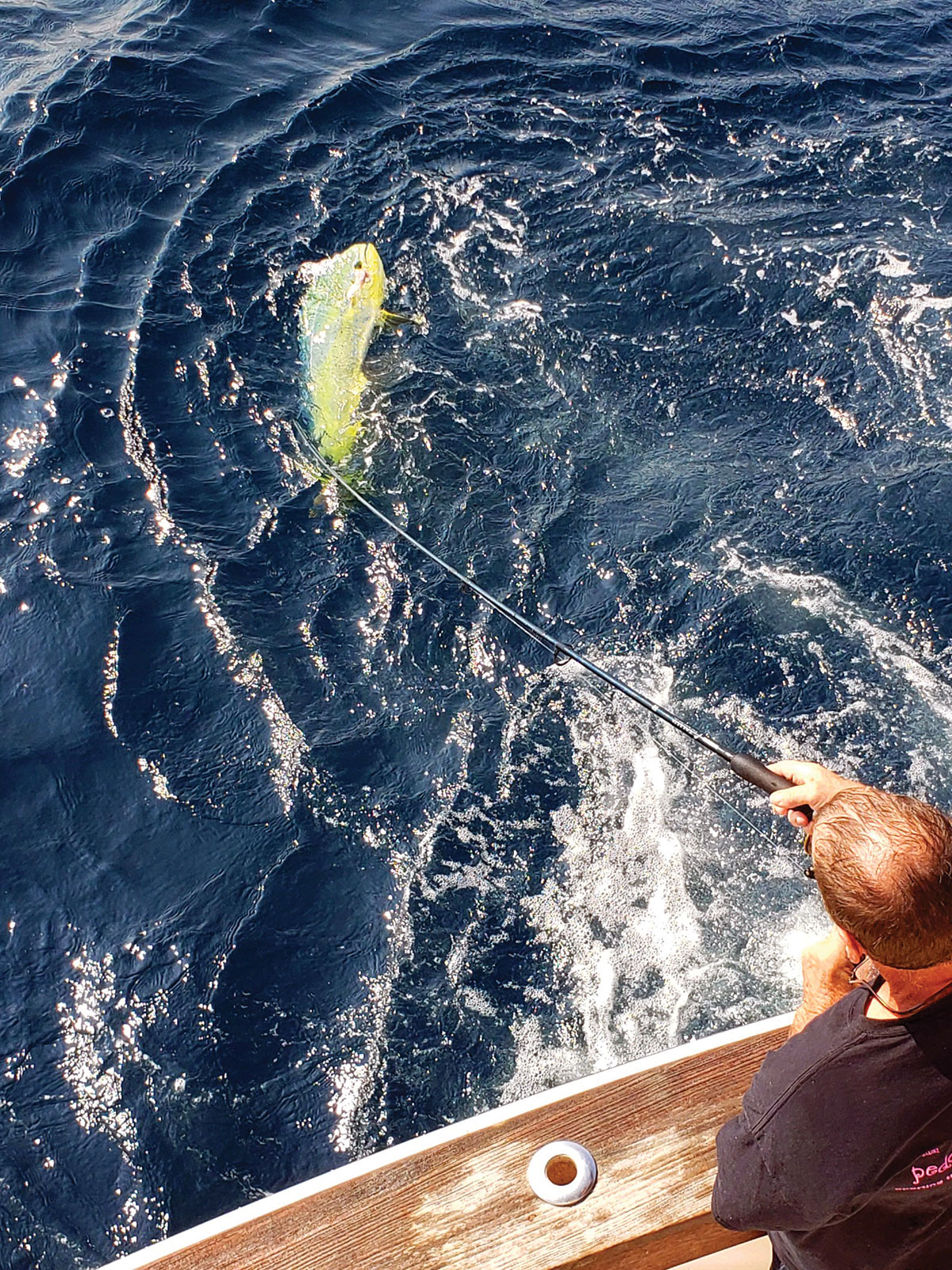
A slew of mahi tricks from a seasoned captain and past Dream Boat Fishing Challenge winner.
“There he is! There he is!” We franticly shouted to one another! As we set up on the drift above an offshore high-flyer a massive greenish-blue streak with that ever distinctive yellow tail bolted below a school of gaffer-class mahi mahi. Immediately I knew I was not dealing with the next chicken in the coop!
Even though it was a slick calm day there was a strong current that seemed to suck us right past where the pod of these fish were holding. As much as I wanted to motor straight back, I looped around them up-tide and drifted in stealth mode while setting up to not scatter the school. It was no time for an education.
We had numerous mahi pushing 20 pounds already as day one offshore was being dedicated to hunting down that oversized bull. It was a run-and-gun kind of day; we must have had already hit 25 different sets of gear with great results but had not found quite what we were looking for, but this was it—clearly the largest one we had seen all season.
As I swapped out for heavier gear, and dug through the fresh tote of dragger baits, I hooked up the largest butterfish I could quickly find, sent a handful of baits overboard and in went my hook bait. Quite to my disappointment a beautiful 14-pound-class cow that was voraciously competing for growth rights inhaled that big butter. They were in a blitz so I locked the drag up and had to horse the fish because once again I did not want to educate them. I knew getting through these large dolphinfish was going to be a challenge before they shut off. So again I dug through the tote and this time opted for a whiting that was about 14 inches long—yes 14 inches—and repeated the cycle. Somehow my oversized offering slid by the baits being devoured and I just kept paying my line back, back, back; and right when I was losing all hope my line ripped to the side as this massive block head bull went aerial numerous times with the hook set hard.
With my heart racing I knew the end game was near. This was not my time to be the gaff man as I was the angler and had to trust in my seasoned fishing partner. As Pat bumped the fish with the small mahi gaff he shouted, “I need the big gaff!” The next pass he hit his mark and landed what would be the largest bull of the season and secured the top spot in the Dreamboat Fishing Challenge that season.

Without question large cows and bulls can quite possibly be anywhere the water is hot and blue. In fact, we’ve caught some monsters late in December in cold, green water, but trust me when I say that we were not expecting it! We’ve also caught them trolling in complete open water with no debris around at all. That’s what I call luck, as mahi love structure, and I truly believe they were just moving from one home to another when our paths crossed.
As a child growing up on a pond there was no bass safe from us. We would go straight to the dock. We knew where they lived. Hunting oversized mahi are not much different, so don’t over think this. Yes it’s a further run; yes they taste better; and yes the rewards are a hell of a lot greater.
As you question how big of a vessel you need bear in mind we caught all of ours from the platform of my 23 Regulator, “Three Deep.” With that being said let’s set our focus on the Shipping Lanes south to my favorite, the 75- to 100-fathom curves. From Hudson to Hydros we’ve caught some mighty large mahi over the years leaving all the way from Stonington, CT.
As you run offshore keep a sharp lookout for the needle in a haystack, the floating log, pallet, etc. Although these finds can be great they’re not nearly as plentiful as the buoys and high-flyers that mark the offshore lobstermen’s gear. When approaching depths of 400 feet and greater, it is on this bottom structure that you will find myriad mahi hotels. Most trawls are marked by the aluminum beacon—aka high-flyer and poly ball—which are tethered to the traps in the deep with heavy warp. Over time, this rope grows weeds, mussels and marine life which in-turn attracts and sets off the entire food chain. Sometimes the gear may have just been hauled, pressure washed and reset, so if no one is home and the gear is clean, push on; the very next ball could be loaded with fish.
Keep in mind your sea surface temperature (SST). This is a very important factor as these pelagics truly prefer temps well above 70 degrees. My favorite is 74 degrees to 78 degrees. Don’t waste your time in cold water. We’ve certainly caught a few over the years in 65 degrees at the end of the year, but we have witnessed massive schools that seemed to be dazed and confused with complete lockjaw as they seem to be praying to run back into that hot blue eddy. Being one of the fastest growing fish in the ocean, mahi thrive in the northeast during our late summer and fall months when our canyons are full of nutrient-rich water and life.

As a word of advice, if it’s the largest bulls you’re after “beat the fleet!” Think of it like opening day trout fishing; if you stand elbow to elbow with a million hooks in the water then your chances are drastically reduced. Leave and find a spot alone. Steer clear of the fleet that had a tuna bite earlier and now everyone is “on the ball.” These spots will get picked over quickly and what’s left will stop biting if they’re not already on ice. If we are on a bull hunt I prefer to be nowhere near the fleet of boats and instead all alone along the edge of the blue abyss.
In fact if you’re staying for an overnighter and you do find that large bull that has lockjaw from the fleet, mark the gear on your GPS and return first thing in the a.m. while the tuna fleet is hard at work. Chances are as much as they eat you may ice him on your first pass!
Last year it was our second night out and we were pot-hopping between the Dip and Middle Grounds on our way home when we came across the largest bull I’ve ever laid eyes on. He had a large tear on his block head, probably from a trolling spread that did not hit the mark as he jumped it off. The fish was a solid 60-plus pounds; an absolute monster mahi of the deep. After throwing every trick in the book at him we actually contemplated staying another night just to be the first ones on that gear in the a.m., but as fate would have it, land-dwelling responsibilities came calling and we left with our tails between our legs. No doubt the next day he would have overlooked that scar to inhale a properly-presented bait.
After you set your sights on a starting point, preferably the 100-fathom curve mixing with clean blue water and those desirable temps with structure discussed, prepare your gear. As rod and reel can be a topic of its own, we’ll go straight to the leader. I prefer an 8-foot section of 40- or 60-pound fluorocarbon pulled taught to remove any memory, then connected to your mainline via an 80-pound Spro swivel. These fish get smart in a hurry, so keep your leaders long, clean and straight.
Dorado are not a fish you want to use circle hooks on as they seldom turn and run after eating. Instead use a heavy-duty offset j-hook, and don’t, I repeat DON’T be the one that casts your bait out with the hook hanging carelessly out of your bait. Whether it be a whole squid, cut butter or that whole whacky whiting, make sure you take the time each and every cast or drop to make sure the hook is concealed inside of your offering. It’s the smallest of details that will consistently make the difference between putting those slammer bulls on ice or not.
Lastly, don’t rush things when you do eventually come across that monster mahi; he was hanging out there long before you arrived. Set your gear, pay attention and be patient as you may just feel your drag go “running with the bulls.”


